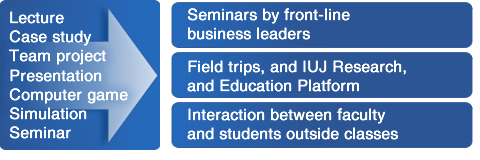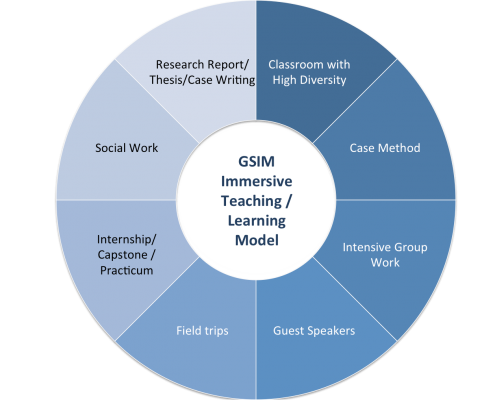Teaching Methodology
IUJ Business School Teaching Methods
Relating classroom teaching to “real business practices” is the aim of any business school. But, many business schools lack the kind of “real business environment” to make the business teaching meaningful. IUJ is different. At anytime you will find about 30 multinational corporations represented in the student body. Plus the kind of global environment which only a few top business schools in the world can offer a student body with a variety of backgrounds from 40 plus countries. Our team projects are designed in ways for students to learn how to communicate, lead, find problems and solutions, negotiate, and facilitate changes in organizations.
Established by close to 1,000 companies, including multinationals such as Sony, Matsushita, Toyota, we maintain a close relationship with the business community. Our regular guest speaker series attracts top business and government executives to the campus where students have ample opportunity to interact with them and hold face-to-face discussions.
Our superior IT environment provides excellent learning tools and databases for extensive business research.
IUJ MBA Program’s Teaching Methods

GSIM’s Teaching/Learning Model
GSIM fully utilizes its key advantage of a campus located in a local rural area. Students and faculty live all the time on campus obligatorily for the first year if they belong to the two year program, whereas students in the one year programs are expected to live on campus unless special permission is granted upon request. With a campus having students coming from around 35 countries every year, students are exposed to a multicultural and multinational environment.
The GSIM Teaching/Learning Model is complemented by eight major components as outlined in the Figure below. Though there are still many traditional lecture type classes, these classes include interactive activities such as student presentations analyzing companies and other organizations both from inside and outside Japan. For the core courses, teaching assistants are recruited from among students to supervise the learning of students and oversee exams. The Case Method is being increasingly used both for qualitative and quantitative courses. Students are challenged with intensive group work, 4-5 guest speakers every academic term, 3 or 4 major field trips a year plus several short study tours by class instructors. Carefully designed opportunities for volunteer/social work assure continuous engagement and exposure.
In addition to student exchange agreements with overseas schools, depending on program types, students are required to complete internships (for the MBA), a Capstone program (for the IMBA), and a Practicum (for the E-Biz Program). Students are required to submit a Research Report/Thesis for the completion of their study at GSIM. Research outputs in the form of Research Reports fit better with business and management oriented students. Outputs in the form of a thesis suit students from social enterprises and government sectors.
In summary, our teaching philosophy emphasizes context specificity and relevance and a cross-disciplinary approach in delivering content while keeping in mind the complexity of managerial decision-making and the great diversity among our student populace and faculty members (at least seven nationalities are represented, in a small-sized core faculty).


